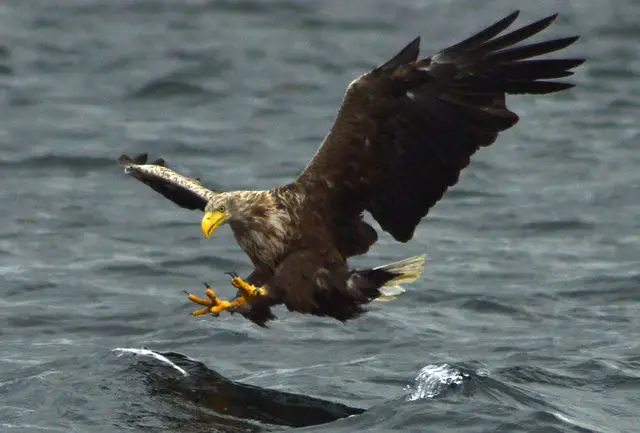Susan shares this latest news on behalf of the Forestry Commission. Ed
Plans to return white-tailed eagles to the South of England have taken a step forward after a licence was issued by the Government’s wildlife licensing authority, Natural England.
The licence to reintroduce Britain’s largest bird of prey was granted to The Roy Dennis Wildlife Foundation and Forestry England who will undertake a five year reintroduction programme based on the Isle of Wight.
Last known breeding place: Culver Cliff in 1780
White-tailed eagles were once widespread across Southern Britain until the eighteenth century when persecution and human activity lead to the birds being wiped out.
The last known breeding place in the region was recorded at Culver Cliff on the Isle of Wight in 1780.
Boost to economy
The project could give a significant boost to the Island economy after a similar scheme on The Isle of Mull was found to have boosted its local economy by up to £5 million a year.
Roy Dennis, Founder of The Roy Dennis Wildlife Foundation said,
“White-tailed eagles were once a common sight in England and southern Europe but were lost centuries ago. This project aims to reverse that situation by restoring the eagles to their ancestral nesting places. I can remember as a lad walking along Culver Cliffs to see where the eagles had once lived.
“It is incredible now to be able to play a part in returning these birds back to their home. We look forward to working with a range of organisations on the Island, and in the Solent area, to help make this exciting project a success.”
Forestry England: Proud to be involved
Bruce Rothnie, South Forest Management Director, at Forestry England, said,
“Our woodlands provide a haven for wildlife and we hope that they will become home to these incredible birds on the Isle of Wight.
“This long term project is a great opportunity to help to restore the white-tailed eagle to the South Coast of England and we are proud to be involved in helping to bring back this rarest of birds to Britain.”
Environmental priority
Reintroducing these birds is a priority in the Government’s 25 Year Environment Plan. Implementation of the licence will be closely monitored by Natural England.
Public support for the project has been high with 76 per cent of local people surveyed supporting the reintroduction of the birds to the area.
Eight foot wing span
The majestic white-tailed eagle has a wing span over eight foot and a brown plumage with a pale head and distinctive white tail. Over the next five years young birds, bred in the wild in Scotland, will be reintroduced on Forestry England woodland on the Isle of Wight.
The young birds will be released once they are familiar with their new home and will initially be fed to encourage them to settle along the South Coast.
Breeding not expected until 2024
It will take several years for the young birds to become established and breeding is not expected to start until at least 2024. During this time the birds will be closely monitored using satellite tracking devices.
Data on the movement of the birds will be available on the Roy Dennis Wildlife Foundation website and once the birds are well established it is hoped that viewing areas can be set up to allow visitors to observe the birds.
Why the Island?
The Isle of Wight was chosen as a location for the project given its central position on the South Coast, an ideal habitat for these coastal loving birds.
In time it is hoped the birds will spread east and west along the coast and also help to link up existing populations of white-tailed eagles living in Ireland and the Netherlands.
The Island offers an ideal habitat for the birds with its numerous potential nesting sites in woods and cliffs, and is located close to highly suitable foraging areas for fish and other food in the Solent and surrounding estuaries.
Tann: Must help, not hinder, existing wildlife
Commenting on the decision by Natural England to license the reintroduction of white-tailed sea eagles to the Island, Debbie Tann, Chief Executive of Hampshire and Isle of Wight Wildlife Trust, said:
Image: wildlife_boy1 under CC BY 2.0“This could be a great leap towards a much wilder future for the Island. The sight of this iconic eagle around the southern English coast cannot fail to inspire people and encourage the kind of love for wildlife which will be vital if we are going to tip the balance in favour of nature’s recovery.
“We have been clear that this programme must help, not hinder, our area’s existing wonderful wildlife and we have been impressed with the work undertaken by the project team to date. We look forward to working together to ensure that this initiative brings real and tangible benefits for the Island’s wildlife and local communities.”





